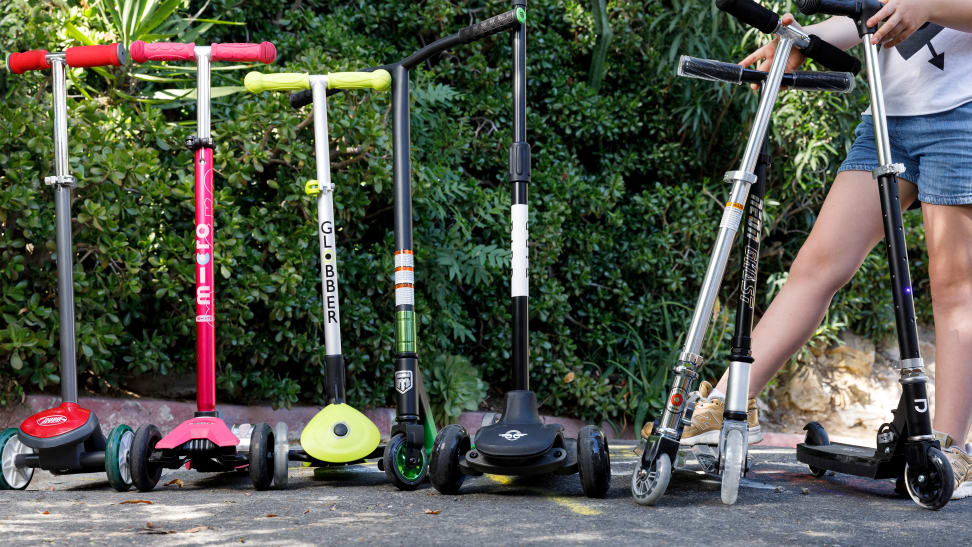 — Recommendations are independently chosen by Reviewed’s editors. Purchases you make through our links may earn us a commission.
— Recommendations are independently chosen by Reviewed’s editors. Purchases you make through our links may earn us a commission.My two kids are in full pandemic mode, with camp non-existent, parks closed, playdates off-limit—you know the drill. One of the few ways they can get exercise is by scootering around the neighborhood. With an abundance of time on our hands, and a propensity for scooting, we tested out nine different kick scooter models. Along the way I learned the basics (like two-wheels vs. three-wheels) and the mundane (polyurethane vs. plastic wheels). I also injured my ankles quite a few times while riding along on my own personal electric scooter (which is a Razor Power A2, if you’re interested).
After miles of rides around our Los Angeles neighborhood, I can say without hesitation that the best three-wheel scooter is the Micro Kickboard Maxi Deluxe LED (available at Amazon) and our top pick for the best two-wheel scooter is the Jetson Jupiter (available at Amazon).
Here are the best three-wheel scooters we tested, ranked in order:
- Micro Kickboard Maxi Deluxe LED
- Globber Elite Deluxe Lights
- Bird Birdie
- Radio Flyer EZ Glider
Here are the best two-wheel scooters we tested, ranked in order:
- Jetson Jupiter
- Y-volution Neon Ghost
- Razor Original A
- Fuzion X-3
- Mongoose Rise Pro 100
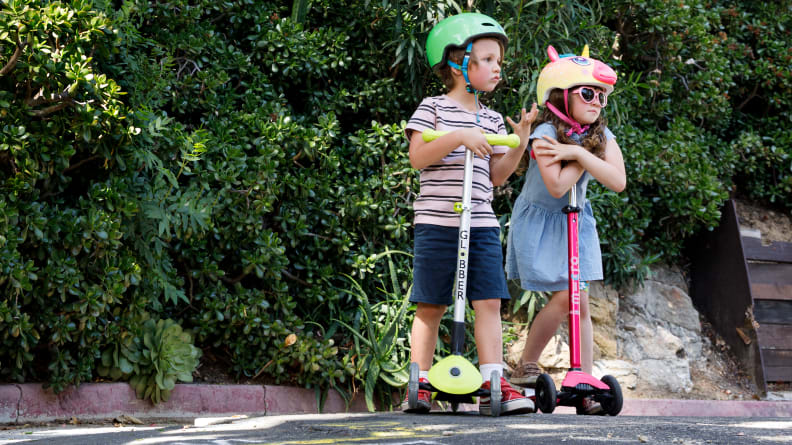

The Maxi Deluxe is our top choice for 3-wheel scooters.
Micro Kickboard is one of the most popular scooter brands right now, and it’s no wonder. These scooters are solidly built, provide a smooth ride, and they’re pretty cute, too. The Micro Maxi Deluxe is best for ages 5 to 12—it supports up to 110 pounds—and features an adjustable handlebar to grow with your child. A rubber grip handlebar and an intuitive lean-to-steer design make it easier for newbies to learn to ride. We found that younger kids took a few days to adjust to using the rear step brake—often they would just drag their feet to stop the scooter—but once they figured it out they were able to safely and effectively slow and stop the moving scooter.
The Maxi Deluxe is super easy to set-up—all we had to do was insert the handlebar—and my kids loved the motion-activated light-up wheels (I liked that it doesn't require any batteries). The Maxi Deluxe comes in a variety of different colors, and it felt durable enough to hold up to use from more than one kid. One thing to note, however, is that the Maxi Deluxe does fade quickly when left out in the sun. To maintain the bright color of your child's scooter for as along as possible it's best to store it out of the elements. The Micro Maxi Deluxe comes with a two year warranty, and all the parts are replaceable.
For kids younger than 5, the Mini Deluxe offers similar design and functionality, but it's sized for smaller children.
Pros
-
Smooth ride
-
Available in lots of colors
Cons
-
Pricey
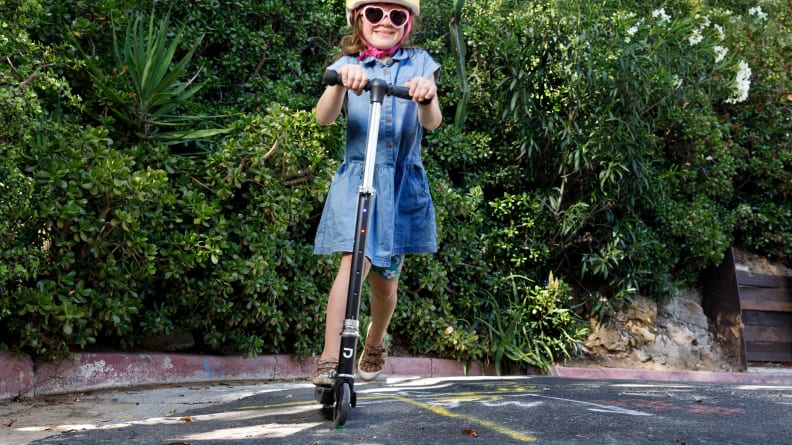

The Jetson Jupiter is our favorite 2-wheel scooter.
The Jetson Jupiter is a classic metal two-wheeler with the addition of over 100 LED lights on both the body and the wheels. The Jetson Jupiter is lightweight and easy to fold, so it wasn't hard for my kids to pick it up and carry it when they got tired of scooting (which inevitably happens). The price of the Jetson Jupiter is comparable to that of its popular alternative, the Razor Original A scooter, but we liked it better. We also liked that the rear foot brake is easy for kids to access, an important feature when first learning to ride or cruising down hills. The one drawback to the Jetson Jupiter is that it requires three double-A batteries in order to activate the lights. Available in pink, blue, and black, the Jupiter has an adjustable handlebar and is best for ages 5 and up.
Pros
-
Cool LED lights
-
Easy to ride
Cons
-
Requires batteries
How We Tested
The Tester
I’m Lindsey Hunter Lopez and I’m a freelance writer and a mom (I think I covered that part) and I write about toys pretty often. I can’t help myself—it’s fun! I also love researching solutions to parenting issues including ways to celebrate kids’ birthdays while quarantined and the best way to get your child’s ears pierced.
The Tests
We rode the scooters all over our hilly Los Angeles neighborhood to get a good sense of how they perform. I had my 5-year-old and 6-and-a-half-year-old, and a few other kids, test all the scooters. My husband and a friend’s husband also tested the scooters meant for bigger kids (the Fuzion X-3 and the Mongoose Rise Pro 100) for durability. We tested both subjective and objective factors, asking questions like, “How easy is it to assemble the scooter?” and “How smooth is the scooter’s ride?” The scoring was based on the 4- to 8-year age range.
What You Should Know About Kids Scooters
Wheel Quality
What I didn’t fully realize before I started testing scooters is that there is a difference between the two- and three-wheel models. The other thing about wheels: material matters. When my daughter was around 2 years old, she had a toddler scooter, specifically the Radio Flyer My 1st Scooter. It barely rolled! So it never got used. Scooters that don’t scoot are not fun. So make sure your scooter has quality wheels, such as the thick polyurethane wheels on the Micro Kickboard models. Polyurethane wheels provide a much smoother and faster ride than the plastic or PVC wheels found on less expensive scooter models. If your scooter rider has plans to do tricks, look for wheels with a metal core as they will be better able to withstand serious impact.
Wheel Size
If your child is planning to travel bumpy urban sidewalks or rocky rural terrain on their scooter, you're going to want to opt for a model with larger wheels. The larger scooter wheel will provide a smoother ride over cracked sidewalks or bumpy lanes. Larger wheels absorb shocks more effectively, providing a smoother—and safer—ride.
Two Wheels vs. Three Wheels
Generally, three-wheeled scooters are best for newbie scooter riders and smaller kids ages 2 to 6. The design of two wheels in front and one wheel at the rear provides extra stability for riders whose ability to balance may not be fully developed. The three wheel models have wider foot decks, so that kids can ride with their feet next to each other—also helpful for balance. My daughter is turning 7, and she just requested a two-wheel scooter because apparently that’s what her friends have. So if your child is in the 6 to 7 range, they may prefer a more “grown up” two-wheel model. But the three-wheel models we looked at are large enough for kids up to about age 10 (maximum weight was 110 pounds for both kinds).
What to Look for in a Scooter for Bigger Kids and Teens
We were testing scooters primarily with the ages 4 to 8 in mind, but kids ages 10 and up may prefer a sturdier ride. Scooters made for bigger kids tend to be more solid and have weight limits that can accommodate adults. Some stunt scooter models even feature accessories that make it possible for riders to do tricks. Scooters designed with older riders in mind tend to have smaller wheels, making them more maneuverable for tricks, but harder to balance on.
Do You Need Extra Features?
I find the little extras, namely light-up wheels, are worth the higher price tag. Kids go nuts for light-up wheels, I’ve discovered. Plus, lights make nighttime scooter rides safer. If your child needs even more incentive to get off the couch and go for a ride, look for scooter accessories that can be purchased separately to make each child's scooter truly unique. Micro Kickboard offers Scooter Heads, adorable animal characters that can be attached the handlebars of your child's scooter.
Don’t Forget Safety Gear
Your kid must wear a helmet, even if they're just riding up and down your flat driveway. If you want to make sure they're really safe—and avoid meltdowns over skinned knees—you might want to get some knee and elbow pads, too.
Other Three-Wheel Scooters We Tested

The Globber Elite Deluxe scored just a hair lower than the Micro Kickboard model, but the Globber has a lower price point. It’s a fantastic value for the money, and we loved it. The Globber Elite Deluxe Light’s ride is just as smooth as the pricier Maxi Deluxe LED, but it folds up for easy storage, making it a great choice for families who are short on space. The feature that really sets the Globber apart is the design of the T-bar. It easily clicks into place, and with just the push of a button and a half turn, the bar folds flush against the foot board. It has a four-position adjustable handlebar, dual color hand grips, and, of course, it features light-up wheels (no batteries required). The Globber Elite Deluxe is perfect for kids ages 3 and up, and it comes in lots of bright colors.
Pros
-
Great value
-
Folds easily
Cons
-
Not as sleek as some other models

Known for its adult scooters, Bird brand’s Birdie scooter is a cool-looking three-wheeler for ages 3 and up. It’s a great entry model for young preschoolers due to its large wheels. Unfortunately the larger wheels aren’t as quick and smooth as the Micro Kickboard and the Globber. The lean-to-steer design functions just as well as our top scooters, though, and the Birdie also features a rear stomp brake. While the sleek design of the Birdie will definitely appeal to parents with a minimalist aesthetic, the no-frills scooter didn't win any points with our young testers. The Birdie comes in black, white, and pale pink, but there are no light-up wheels or bright primary colors. The Birdie has a height-adjustable handlebar, and a maximum weight limit of 110 pounds.
Pros
-
Sleep look
-
Smooth ride
Cons
-
Cost
-
No extra features

The Radio Flyer EZ Glider is a step up from the aforementioned My 1st Scooter, but it’s still not fantastic. Its urethane wheels aren’t smooth like the high-quality ones on our top picks, so it doesn't glide as easily. It does have an adjustable handlebar and foam-padded handles, but with a weight limit of only 60 pounds, your child is likely to age out of the Radio Flyer pretty quickly. While the Radio Flyer does feature lean-to-steer technology, our testers found that it was difficult to maneuver and had a pretty dismal turning radius. Another drawback: aesthetically, it’s not as appealing as the other models we tested, and it doesn't have wheels that light up.
Pros
-
Easy for toddlers
-
Wide foot base
Cons
-
Bad turning radius
-
Bumpy ride
Other Two-Wheel Scooters We Tested
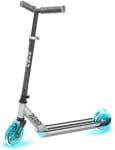
The Y-volution Neon Ghost was popular with our testers; it’s comfortable to ride, a manageable weight, and it looks very cool. One of the most unique features of the Neon Ghost is that the lighting is customizable. With 10 different colors and three different modes—pulse, strobe, or solid—the rider can program the look of their scooter with just the push of a button. The Neon Ghost has an adjustable handlebar, anti-slip handlebars, and a wide rear brake, making it both safe and fun for young riders. It should be noted, however, that over time the wheel began turning independently from the handles, which brought this model down in the ranks.
Pros
-
Customizable lighting
-
Reasonably priced
Cons
-
Not durable

The Razor Original A is a classic scooter model, and a very popular one. We found the metal frame to be a bit wobbly, and watch out for the deck swinging all the way around when you lift it up (this is how I hurt my ankles all the time on my own Razor). The Razor has an adjustable handlebar, but some of our testers found that it didn't extend high enough to work for taller riders. It does set itself apart by being lightweight and easy to fold, which makes The Razor a great pick for kids who take public transportation. The urethane wheels provide a fast, smooth ride, and the rear fender brake was easy for experienced scooter riders to utilize. Overall, a Razor scooter is a solid pick for the money.
Pros
-
Affordable
-
Lightweight
Cons
-
Wobbly
-
Short handlebar
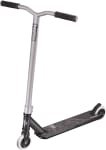
The gold color of the Fuzion X-3 was popular with my testers, and this model is sturdy but not too unwieldy. It’s a great option for older kids who are beyond an entry-level scooter and want to start getting into scooter tricks at the skate park, especially because it looks "cool" and not "cutesy". We liked that the Fuzion X-3 came ready to ride when it arrived—we just had to tighten a few bolts with the included wrench before hitting the streets. The wider-than-average handlebar makes it ideal for learning to do tricks, and the rear brake is squeak-free. With a weight limit of 220 pounds the Fuzion X-3 can handle heavy use from kids to teens and beyond.
Pros
-
Sturdy but manageable
-
Noiseless brake
Cons
-
Small wheels

My husband had fun testing the Mongoose Rise Pro 100; its heavy-duty frame make it the sturdiest scooter we tried. The ultra-wide handlebars can be hard for little kids to manage, but this scooter is perfect for bigger, stronger kids and teens. This is not a scooter for beginning riders—it's designed for kids ages 8 and up—but if you have an older child who wants to take their scooting to the next level, they'll love the Mongoose. Alloy pegs mean the Mongoose is ready for stunts, and it has a weight limit of 220 pounds, but if your rider is on the taller side, they may find the handlebar too short.
Pros
-
Rugged
-
Holds up to 200 lbs.
Cons
-
Heavy
-
Not for beginners
